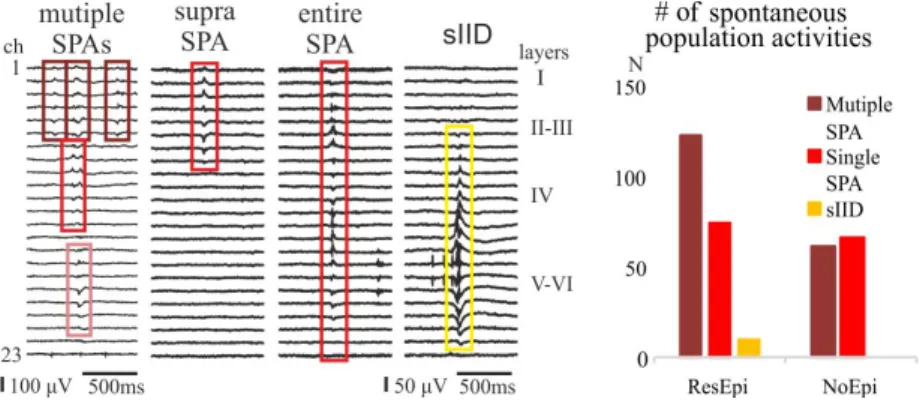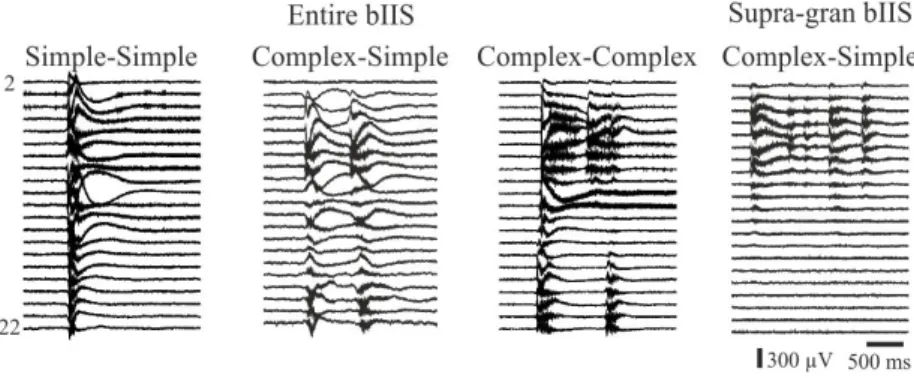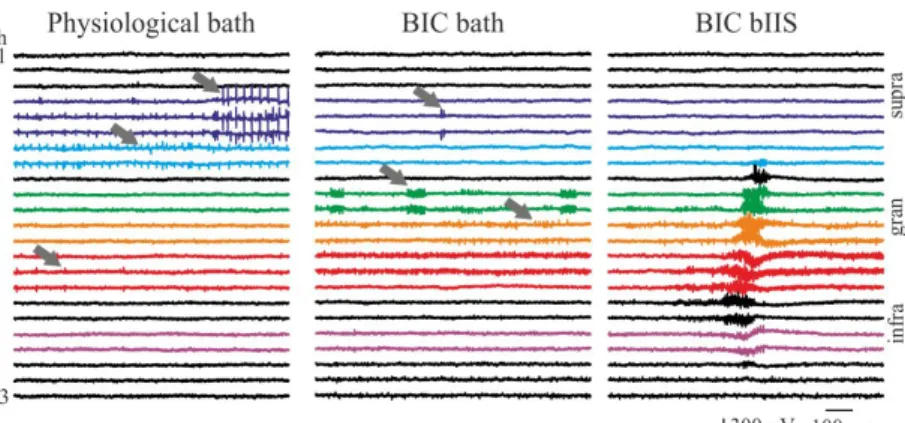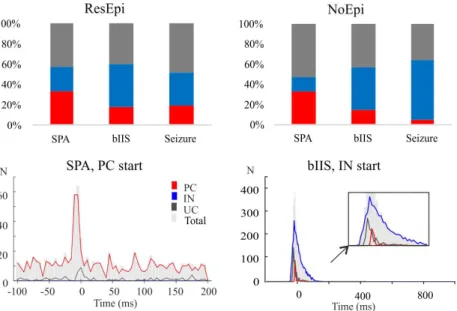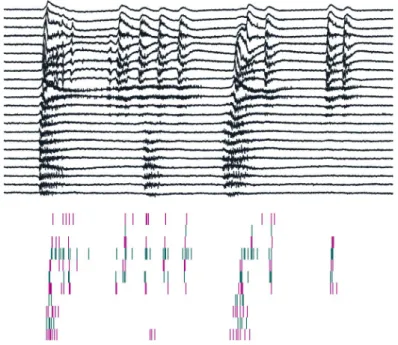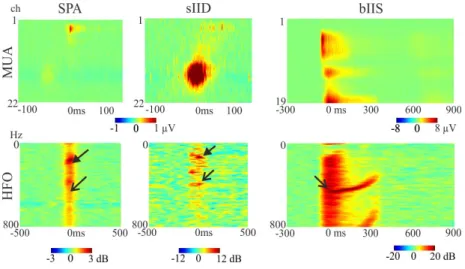Spontaneously occurring and disinhibition-induced synchronous activities in the human neocortex, in vitro
Ágnes Kandrács
Theses of the Ph. D dissertation
Scientific advisor:
Lucia Wittner, PhD
Pázmány Péter Catholic University Faculty of Information Technology and Bionics Roska Tamás Doctoral School of Sciences and Technology
Budapest 2019
1 Introduction
Hypersynchronous discharges observed in postoperative human neocortical slices are thought to be the outcome of epileptogenic processes. Both human and experimental focal epilepsies are characterised by the presence of high amplitude, fast EEG spikes followed by a slow wave, the so-called interic- tal spikes (IISs) [1]. At the same time, spontaneous synchronous population activities were observed on slices prepared from the human epileptic neo- cortex [2]–[6] or the hippocampal formation [7]–[11] during physiological conditions. These spontaneous population bursts had a waveform resembling in vivo IISs [7], [12], [13]. Since healthy human tissue was not available for obvious ethical reasons, researchers reached for animal brain preparations as a control. However, the comparison of distinct species has its pitfalls as well.
No spontaneous field potentials could be detected in vitro in healthy rodent [3], [14] nor primate [15] neocortical slices. Though populational spiking was evoked by activating a single PC in neocortical slices of tumour patients [16].
Moreover, the observation of population activity arising in healthy rodents and primate hippocampal slices raised the possibility that synchronous bursts are not related to epilepsy [15], [17].
It is important to understand the cellular characteristics and firing pattern of single neurons to reveal the contribution of different circuits to the genera- tion of synchronous events. The paroxysmal depolarisation shift and bursting behaviour were linked to the initiation of IISs in animals [1]. The leading role of bursting excitatory cells in the generation of hypersynchronous events was proposed by the observations in theMg2+-free [14], in the K+-channel blocker 4-aminopyridine [18], as well as in the bicuculline [19] models of epileptiform activity in the human neocortex. The physiological conditions
of the cortex are associated with the dynamic balance of excitatory and in- hibitory mechanisms. In epilepsy, this balance is disturbed during seizure ac- tivity [20]. It has been shown that seizures with different onset were gener- ated by different mechanisms. Some hypersynchronous events were initiated by interneurons [20]–[22], while others were triggered by the enhanced exci- tatory processes [3], [9], [21] in both human and experimental epilepsy.
In the present study, postoperative human neocortical slices derived from epileptic and non-epileptic (tumour) patients were investigated. The first at- tempt was to show whether human neocortical circuits are able to maintain synchronous activity spontaneously, without the presence of an epileptogenic agent. The contribution of different neural networks to the population events was compared between the patient groups. Henceforth, theGABAAreceptor- mediated transmission was eliminated to investigate further the role of dif- ferent cortical circuits in the synchronisation. The present study attempted to compare the different population activities emerging in the non-epileptic, the epileptic and the disinhibited human neocortex.
2 Methods
Postoperative neocortical tissue was resected from epileptic and tumour pa- tients. Slices of 500µm were prepared, then electrophysiological recordings were obtained in an interface chamber, on body temperature, in the presence of oxygenated physiological solution or bicuculline bath (bicuculline methio- dide, Tocris Bioscience). Local field potential gradient (LFPg) was obtained by a laminar multielectrode with 24 contact points and 150 µm of inter- contact spacing [10], [12], [13], [23], [24]. The electrode was placed on the brain slices perpendicular to the pial surface so that it covered all the neocorti- cal layers. Local field potential deflections were detected, then current-source density, multi-unit activity and time-frequency analyses were performed. The frequency, amplitude and length of different synchronous events, as well as the propagation pattern of bicuculline-induced events were calculated. The lo- cation was determined by using the functional division of the cortical layers:
supragranular layers (layers I-III), granular layer (layer IV) and infragranu- lar layers (layers V-VI). The action potentials (APs) of cells were clustered on recordings with observable population activities. The firing behaviour of the single units was examined. Different cell types were distinguished by the shape of the AP and the nature of the autocorrelogram. To monitor the behaviour of different cell types during the distinct synchronous events, the normalised firing change was calculated using the perievent time histogram.
After that, the contribution of the neurons to the initiation of the population activities was determined.
3 Novel scientific results
Thesis groups 1: The emergence of population synchronies in the human neocortex
Thesis Ia: I have revealed that postoperative human neocortical slices are able to generate distinct types of synchronous activities, in vitro.
I have observed four distinct types of synchronous events with different mor- phologies in the human neocortex, in vitro. Spontaneous synchronous popula- tion activities (SPAs) emerged in physiological solution regardless of the pa- tient groups. In the meantime, spontaneous interictal-like discharges (sIIDs) developed in physiological solution as well, but only in slices derived from epileptic patients. In bicuculline bath, spontaneous activities disappeared, while bicuculline-induced interictal-like events (bIISs) or seizures arose. I have observed these synchronies in both epileptic and non-epileptic patient groups.
Figure 1: Different types of synchronous population events emerging in the human neocortex in vitro.
Thesis Ib: I have established that postoperative human neocortical tissue derived from epileptic patients manifest a higher level of excitability.
More epileptic slices generate synchronous population activities compared to non-epileptic tissue. Epileptic slices develop multiple synchronies more often, and this synchronies have higher field potential amplitude. Hypersyn- schronous discharges resembling in vivo interictal spikes emerge only in tis- sue derived from patients with epilepsy in their anamnesis. The blockade of GABAAreceptors results in a higher level of synchrony with more complex events in epileptic slices compared to non-epileptic slices. All these data pro- pose the enhanced excitability of neural circuits in neocortical tissue derived from patients with epilepsy.
Figure 2: The occurrence of spontaneous population activities in physiolog- ical solution. Slices derived from patients with pharmacoresistant epilepsy (ResEpi) tend to generate more multiple SPAs compared to those derived from tumour patients without epilepsy (NoEpi). Only ResEpi tissue devel- oped sIID, which implies a higher level of synchrony.
Thesis Ic: I have confirmed that smaller neuron populations (hubs) are able to generate hypersynchronous events in the epileptic neocortex.
In the disinhibition model, slices of epileptic patients develop spatially and temporally complex interictal-like events, unlike non-epileptic slices. Epilep- tic tissue is able to generate spatially more restricted bIISs as well. Only events spreading through all the layers of the neocortex emerge in the non- epileptic tissue. This suggests that smaller cellular networks (hubs) are able to maintain hypersynchronous discharges in the epileptic neocortex.
Figure 3: The complexity of bIISs. NoEpi slices generated only temporally and spatially simple (simple-simple) events which invaded the entire neocor- tex. In contrast, bIISs emerged in the ResEpi tissue showed high temporal and spatial complexity, sometimes restricted only to neuron populations be- longing to a subset of the neocortical layers (e.g. the supragranular-granular layers).
Thesis groups 2: Synchronisation on the cellular and net- work level in the disinhibition model
Thesis IIa: I have found that different neuron populations are activated in physiological conditions compared to the disinhibition model.
Those neurons, which are firing in the presence of physiological solution, usually remain silent after the application of bicuculline and vice versa. In the physiological solution, the prominent role of the supragranular layers is observable. During the condition of disinhibition, the close up of the granu- lar layer is apparent. In the physiological solution, principal cells (PCs) are significantly more active compared to interneurons (INs). In the presence of bicuculline, INs take over the leadership.
Figure 4: LFPg recordings of the same recording site in physiological solu- tion, in bicuculline bath and the presence of a bIIS. Different cell populations are activated during different conditions. Grey arrows indicate the action po- tentials of the neurons.
Thesis IIb: I have proven that SPAs and BIPAs are maintained by differ- ent cellular networks.
Only one-half of the active cells are accompanying the SPA. In contrast to that, 90 % and almost 100 % of the detected cells are associated with the bIISs and seizures. SPAs are usually initiated by PCs, while BIPAs are ini- tiated majorly by INs. Similarly, more PCs contribute to the development of SPAs, while more INs participate in the emergence of the BIPAs. Thus, it could be claimed that different neuron populations are involved in different synchronies.
Figure 5: The contribution of the different cell types to synchronous events.
Upper panel: the ratio of neuron types contributing to the events. Lower panel:
An example of enhanced PC firing during an SPA and leading IN firing during a bIIS. PC=red , IN=blue, UC (unclassified cell)=grey.
Thesis IIc: I have uncovered that neocortical circuits are able to maintain synchronised discharges when the GABAergic transmission is reduced.
The disinhibition model shows a high level of synchrony. As the GABAergic transmission is eliminated, and INs have a leading role in the synchronisa- tion, other mechanisms have to be responsible for the collective activation of neuron populations. Probably non-synaptic processes, such as gap-junctions become conspicuous with the blockade of GABAergic inhibition.
Figure 6: Synchronised cell firing during a bIIS. Upper panel: LFPg recording of a complex bIIS. Lower panel: raster plot of the underlying single units.
Action potentials show a high level of synchrony with a leading role of INs despite the elimination of GABAergic inhibition.
Thesis IId: I have shown that the population activities of the non-epileptic neocortex, the epileptic neocortex and those induced by disinhibition re- flect different levels of synschronies.
The field potential amplitude, the level of multi-unit activity (MUA) and the power of high-frequency oscillations (HFOs) show a gradual growth from the SPAs towards the BIPAs. sIIDs recruit more neurons than SPAs, and BI- PAs form an even higher level of synchrony. Furthermore, different neurons and different layers are activated during pathological and spontaneous popu- lational discharges. After the application of theGABAA receptor antagonist bicuculline, the spontaneous activity disappears, while bicuculline-induced epileptiform events start to develop. All these results show that various neuron populations are responsible for distinct events. They all represent a different level of synchronisation in the following order: SPA<sIID<BIPA.
Figure 7: Characteristic MUA (upper panel) and HFO (lower panel) during the population events. Note the different scales.
4 Summary
This research aimed to investigate the physiological and pathological nature of the distinct synchronies raising in postoperative human neocortical slices derived from epileptic and non-epileptic patients in vitro.
It has long been a matter of debate whether healthy human neocortical slices are able to generate physiological population activity. Since human brain slices are not available for obvious ethical reasons, researches reached for animal tissue as control. The results presented in this study propose that the spontaneous synchronous population activity is based on the dynamic bal- ance of excitatory and inhibitory mechanisms. This balance is disturbed in the epileptic tissue. Cortical structures were shown to suffer specific inhibitory cell-loss and the reorganisation of excitatory circuits. Changing the weight of excitatory and inhibitory networks leads to compensatory effects which were destined to maintain the excitability of the system. Advanced spontaneous population activities and interictal discharges might be the evidence for this enhanced tension in the epileptic human neocortex.
The effect of the reduced GABAergic transmission was investigated on the physiological network properties. The disinhibition of the neocortical cir- cuits leads to a disturbance in the balance of excitation and inhibition. As a result, physiological population activities vanished, and in the meantime, epileptiform events showed up. Bicuculline-induced interictal-like activities were uniform in the non-epileptic tissue. In contrast to that, slices derived from epileptic patients generated heterogeneous events. These paroxysmal discharges either spread to the entire neocortex or restricted to smaller re- gions with a high temporal and spatial variability. The results propose that epileptic neocortical slices contain smaller neuron populations which are able
to develop an epileptiform activity.
The data provided here propose that different neuron populations con- tribute to physiological and pathological events. While principal cells had a leading role in the initiation and formation of spontaneous population bursts, epileptiform discharges were dominated by interneurons. The extraor- dinary commitment of inhibitory cells in the disinhibition model proposes that other, non-synaptic mechanisms are also involved in the synchrony gen- eration. Electrical coupling between specific interneurons might be a promis- ing assumption, but further investigation is necessary for confirmation. The results presented here regarding hypersynchronous epileptiform discharges differ from those obtained in epileptic patients or animal models in earlier studies. This suggests that distinct neuron populations are involved in the dis- inhibited human neocortex compared to human epilepsies or animal models of epilepsy. Therefore, the limits of extrapolation should be considered from animals to human as well as from model to the disease before drawing far- reaching conclusions in the case of pharmacologically induced epileptiform activity.
5 Publications
5.1 List of journal publications underlying the thesis
1. Kandrács Á, Hofer KT, Tóth K, Tóth EZ, Entz L, Bagó AG, Er˝oss L, Jordán Z, Nagy G, Fabó D, Ulbert I, Wittner L. Presence of synchrony- generating hubs in the human epileptic neocortex. (2019) JOURNAL OF PHYSIOLOGY 597(23):5639-5670 doi: 10.1113/JP278499
2. Tóth K, Hofer KT, Kandrács Á, Entz L, Bagó A, Er˝oss L, Jordán Z, Nagy G, Sólyom A, Fabó D, Ulbert I, Wittner L. Hyperexcitability of the network contributes to synchronization processes in the human epilep- tic neocortex. (2018) JOURNAL OF PHYSIOLOGY 596(2):317-342 doi:
10.1113/JP275413
5.2 List of journal publications not related to the subject of the thesis
1. Márton G, Tóth EZ, Wittner L, Fiáth R, Pinke D, Orbán G, Meszéna D, Pál I, Gy˝ori EL, Bereczki Z, Kandrács Á, Hofer KT, Pongrácz A, Ulbert I, Tóth K. The neural tissue around SU-8 implants: A quantitative in vivo bio- compatibility study. (2020) MATERIALS SCIENCE & ENGINEERING C 110870 doi: 10.1016/j.msec.2020.110870
2. Hofer KT, Kandrács Á, Ulbert I, Pál I, Szabó C, Héja L, Wittner L.
The hippocampal CA3 region can generate two distinct types of sharp wave-ripple complexes, in vitro. (2014) HIPPOCAMPUS 25(2):169-186 doi:
10.1002/hipo.22361
5.3 Conference posters and presentations
1. Kandrács Á, "Gátlás gátlása az emberi agykéregben.", Magyar Tudomány Ünnepe: Mit tudunk és mit kell megtanulnunk? Kutatások az MTA TTK Kog- nitıv Idegtudományi és Pszichológiai Intézetében, Budapest, Hungary, Nov.
22nd, 2018.(poster)
2. Kandrács Á, Hofer KT, Tóth K, Gy˝ori E, Bagó A, Er˝oss L, Entz L, Jordán Z, Nagy G, Fabó D, Ulbert I, Wittner L. "Synchronization evoked by the GABA(A) receptor antagonist bicuculline in the human neocortex, in vitro."
11th Forum of European Neuroscience, Berlin, Germany, Jul. 7th-11th, 2018.
(poster)
3. Hofer KT, Tóth K, Kandrács Á, Bagó A, Er˝oss L, Entz L, Jordán Z, Fabó D, Ulbert I, Wittner L." High frequency oscillations in human neocortical slices." 11th Forum of European Neuroscience, Berlin, Germany, Jul. 7th- 11th, 2018.(poster)
4. Kandrács Á, "Electrophysiological analysis of synchronization applying bicuculline in human neocortex in vitro" in PhD Proceedings Annual Is- sues of the Doctoral School, Faculty of Information Technology and Bion- ics, Pázmány Péter Catholic University 2017. Prószéky G, Szolgay P Eds.
Budapest: Pázmány University ePress, 2017, pp 24-24.(presentation) 5. Kandrács Á, Hofer KT, Tóth K, Gy˝ori E, Bagó A, Er˝oss L, Entz L, Fabó D, Ulbert I, Wittner L. "Electrophysiological analysis of synchronization ap- plying GABAA receptor antagonist bicuculline in human neocortex in vitro."
HUNDOC, Pécs, Hungary, Sep. 19th, 2017(poster)
6. Hofer KT, Tóth K, Kandrács Á, Szabó Cs, Bagó A, Er˝oss L, Entz L, Fabó D, Ulbert I, Wittner L. Heterogeneous neuronal firing patterns during hu- man neocortical population activity in vitro. FENS Regional Meeting, 2017.
szeptember 20-23., Pécs, Magyarország(poster)
7. Kandrács Á, Hofer KT, Tóth K, Gy˝ori E, Bagó A, Er˝oss L, Entz L, Fabó D, Ulbert I, Wittner L. Electrophysiological analysis of synchronization apply- ing gabaa receptor antagonist bicuculline in human neocortex in vitro. FENS Regional Meeting, 2017. szeptember 20-23., Pécs, Magyarország(poster) 8. Kandrács Á, "The effect of GABAA receptor antagonist Bicuculline on human neocortex in vitro" in PhD Proceedings Annual Issues of the Doc- toral School, Faculty of Information Technology and Bionics, Pázmány Péter Catholic University - 2016. Prószéky G, Szolgay P Eds. Budapest: Pázmány University ePress, 2016, pp 51- 54.(presentation)
9. Kandrács Á, Hofer KT, Tóth K, Gy˝ori E, Bagó A, Er˝oss L, Entz L, Ulbert I, Wittner L. "Investigation of the role of GABAergic inhibition in epileptic human neocortex." From Medicine to Bionics 3rd European Phd Conference, Budapest, Hungary, Nov. 17th, 2016.(poster)
10. Hofer K, Tóth K, Kandrács Á, Szabó C, Bagó A, Er˝oss L, Entz L, Ulbert I, Wittner L. Heterogeneous neuronal firing patterns during human neocorti- cal population activity in vitro. First Joint Conference of From Medicine to Bionics, 2016. november 17-20., Budapest, Magyarország(poster)
11. Kandrács Á, Hofer KT, Tóth K, Gy˝ori E, Bagó A, Er˝oss L, Entz L, Ul- bert I, Wittner L. "Investigation of the role of GABAergic inhibition in epilep- tic human neocortex." 10th Forum of European Neuroscience, Copenhagen, Denmark, Jul. 2th-6th, 2016.(poster)
12. Hofer KT, Tóth K, Kandrács Á, Szabó C, Bagó A, Er˝oss L, Entz L, Ul- bert I, Wittner L. "Heterogeneous neuronal firing patterns during human neo- cortical population activity in vitro." 10th Forum of European Neuroscience, Copenhagen, Denmark, Jul. 2th-6th, 2016.(poster)
13. Kandrács Á, Hofer KT, Tóth K, Gy˝ori E, Bagó A, Er˝oss L, Entz L, Ul- bert I, Wittner L. "Investigation of the role of GABAergic inhibition in epilep- tic human neocortex." IBRO Workshop, Budapest, Hungary, Jan 21st-22nd, 2016(poster)
14. Hofer KT, Tóth K, Kandrács Á, Szabó C, Bagó A, Er˝oss L, Entz L, Ulbert I, Wittner L. "Heterogeneous neuronal firing patterns during human neocor- tical population activity in vitro" HuNDoc Hungarian Neuroscience Meeting for Undergraduate Students, Graduate Students and Junior Post-Docs, Bu- dapest, Hungary, Jan 20th, 2016(presentation)
15. Kandrács Á, "Investigation of the role of GABAergic inhibition in epilep- tic human neocortex" in PhD Proceedings Annual Issues of the Doctoral School, Faculty of Information Technology and Bionics, Pázmány Péter Catholic University - 2015. Prószéky G, Szolgay P Eds. Budapest: Pázmány University ePress, 2015, pp 57- 60.(presentation)
16. Tóth K, Hofer KT, Kandrács Á, Szabó C, Bagó A, Er˝oss L, Entz L, Ulbert I, Wittner L. "Patterns of synchronous population activity in the neocortex of patients with epilepsy or tumor, in vitro." Neuronus IBRO & IRUN Neuro- science Forum, Krakow, Poland, Apr. 17th-19th, 2015(poster)
17. Kandrács Á, Tóth K, Hofer KT, Szabó C, Bagó A, Er˝oss L, Entz L, Ul- bert I, Wittner L. "Investigation of the role of GABAerg inhibition in epileptic and non-epileptic human neocortex, in vitro." Neuronus IBRO & IRUN Neu- roscience Forum, Krakow, Poland, Apr. 17th-19th, 2015(poster)
18. Tóth K, Hofer K, Kandrács Á, Szabó C, Bagó A, Er˝oss L, Entz L, Ulbert I, Wittner L. "Patterns of synchronous population activity in the neocortex of patients with epilepsy or tumor, in vitro." 15th Biannual Conference of the Hungarian Neuroscience Society, Budapest, Hungary, Jan. 22nd-23rd, 2015
(poster)
19. Hofer KT, Tóth K, Kandrács Á, Szabó C, Bagó A, Er˝oss L, Entz L, Fre- und TF, Ulbert I, Wittner L, "Patterns of synchronous population activity in the neocortex of patients with epilepsy or tumor, in vitro." MTA TTK Kálmán Erika doktori konferencia, Budapest, Hungary, Dec. 10th-12th, 2014(presen- tation)
20. Tóth K, Hofer K, Kandrács Á, Szabó C, Bagó A, Er˝oss L, Entz L, Ulbert I, Wittner L. "Patterns of synchronous population activity in the neocortex of patients with epilepsy or tumor, in vitro." Hungarian neurological society meeting, Budapest, Hungary, Nov. 20th-22nd, 2014(poster)
21. Hofer KT, Kandrács Á, Ulbert I, Pál I, Szabó Cs, Héja L, Wittner L.
"The hippocampal CA3 region can generate two types of sharp wave-ripple complexes, in vitro." 9th Forum of European Neuroscience, Milano, Italy, Jul.
5th-9th, 2014.(poster)
22. Tóth K, Hofer K, Kandrács Á, Szabó C, Bagó A, Er˝oss L, Entz L, Fre- und TF, Ulbert I, Wittner L. "Patterns of synchronous population activity in the neocortex of patients with epilepsy or tumour, in vitro." 9th Forum of European Neuroscience, Milano, Italy, Jul. 5th-9th, 2014.(poster)
23. Hofer K, Tóth K, Kandrács Á, Szabó Cs, Bagó A, Er˝oss L, Entz L, Ulbert I, Wittner L. "Patterns of synchronous population activity in the neocortex of patients with epilepsy or tumor, in vitro." Neuronus Conference, Krakow, Poland, Apr. 25th-27th, 2014(poster)
24. Tóth K, Hofer K, Kandrács Á, Szabó C, Bagó A, Er˝oss L, Entz L, Freund TF, Ulbert I, Wittner L. "Patterns of synchronous population activity in the neocortex of patients with epilepsy or tumor, in vitro." International Brain Re- search Organization (IBRO) Workshop, Debrecen, Hungary, Jan. 15th-17th,
2014(poster)
25. Hofer K, Tóth K, Kandrács Á, Szabó Cs, Bagó A, Er˝oss L, Entz L, Ulbert I, Wittner L. "Patterns of synchronous population activity in the neocortex of patients with epilepsy or tumor, in vitro." Society for Neuroscience (SfN) annual meeting, San Diego, USA, Nov. 9th-13th, 2013(poster)
References
[1] M. de Curtis and G. Avanzini, “Interictal spikes in focal epileptogene- sis”,Progress in Neurobiology, vol. 63, pp. 541–567, 2001.
[2] D. A. McCormick, “Gaba as an inhibitory neurotransmitter in human cerebral cortex”,Journal of Neurophysiology, vol. 62, pp. 1018–1027, 5 1989.
[3] R. Kohling, A. Lucke, H. Straub, E.-J. Speckmann, I. Tuxhorn, P. Wolf, H. Pannek, and F. Oppel, “Spontaneous sharp waves in human neocor- tical slices excised from epileptic patients”,Brain, vol. 121, pp. 1073–
1087, 1998.
[4] A. Gorji, J.-M. Hohling, M. Madeja, H. Straub, R. Kohling, I. Tuxhorn, A. Ebner, P. Wolf, H. Panneck, F. Behne, R. Lahl, and E.-J. Speck- mann, “Effect of levetiracetam on epileptiform discharges in human neocortical slices”,Epilepsia, vol. 43, pp. 1480–1487, 12 2002.
[5] A. K. Roopun, J. D. Simonotto, M. L. Pierce, A. Jenkins, C. Nicholson, I. S. Schofield, R. G. Whittakera, M. Kaiser, M. A. Whittington, R. D.
Traube, and M. O. Cunninghama, “A nonsynaptic mechanism under- lying interictal discharges in human epileptic neocortex”,Proceedings of the National Academy of Sciences of the United States of America, vol. 107, pp. 338–343, 1 2010.
[6] J. Pallud, M. L. V. Quyen, F. Bielle, C. Pellegrino, P. Varlet, M.
Labussiere, N. Cresto, M.-J. Dieme, M. Baulac, C. Duyckaerts, N.
Kourdougli, G. Chazal, B. Devaux, C. Rivera, R. Miles, L. Capelle, and G. Huberfeld, “Cortical gabaergic excitation contributes to epilep-
tic activities around human glioma”,Science Translational Medicine, vol. 6, 244ra89, 244 2014.
[7] I. Cohen, V. Navarro, S. Clemenceau, M. Baulac, and R. Miles, “On the origin of interictal activity in human temporal lobe epilepsy in vitro”, Science, vol. 298, pp. 1418–1421, 5597 2002.
[8] C. Wozny, A. Knopp, T.-N. Lehmann, U. Heinemann, and J. Behr,
“The subiculum: A potential site of ictogenesis in human temporal lobe epilepsy”,Epilepsia, vol. 46, pp. 17–21, 5 2008.
[9] G. Huberfeld, L. M. de la Prida, J. Pallud, I. Cohen, M. L. V. Quyen, C.
Adam, S. Clemenceau, M. Baulac, and R. Miles, “Glutamatergic pre- ictal discharges emerge at the transition to seizure in human epilepsy”, Nature Neuroscience, vol. 14, pp. 627–634, 2011.
[10] L. Wittner, G. Huberfeld, S. Clemenceau, L. Eross, E. Dezamis, L.
Entz, I. Ulbert, M. Baulac, T. F. Freund, Z. Magloczky, and R. Miles,
“The epileptic human hippocampal cornu ammonis 2 region generates spontaneous interictal-like activity in vitro”,Brain, vol. 132, pp. 3032–
3046, 2009.
[11] G. Huberfeld, L. Wittner, S. Clemenceau, M. Baulac, K. Kaila, R.
Miles, and C. Rivera, “Perturbed chloride homeostasis and gabaergic signaling in human temporal lobe epilepsy”,The Journal of Neuro- science, vol. 27, pp. 9866–9873, 37 2007.
[12] I. Ulbert, G. Heit, J. Madsen, G. Karmos, and E. Halgren, “Laminar analysis of human neocortical interictal spike generation and propaga- tion: Current source density and multiunit analysis in vivo”,Epilepsia, vol. 45, no. 4, pp. 48–56, 2004.
[13] D. Fabo, Z. Magloczky, L. Wittner, A. Pek, L. Eross, S. Czirjak, J.
Vajda, A. Solyom, G. Rasonyi, A. Szucs, A. Kelemen, V. Juhos, L.
Grand, B. Dombovari, P. Halasz, T. F. Freund, E. Halgren, G. Karmos, and I. Ulbert, “Properties of in vivo interictal spike generation in the human subiculum”,Brain, vol. 131, pp. 485–499, 2008.
[14] M. Avoli, J. Louvel, R. Pumain, and R. Kohling, “Cellular and molec- ular mechanisms of epilepsy in the human brain”,Progress in Neuro- biology, vol. 77, pp. 166–200, 2005.
[15] P. A. Schwartzkroin and M. M. Haglund, “Spontaneous rhythmic syn- chronous activity in epileptic human and normal monkey temporal lobe”,Epilepsia, vol. 27, pp. 523–533, 1986.
[16] G. Molnar, S. Olah, G. Komlosi, M. Fule, J. Szabadics, C. Varga, P.
Barzo, and G. Tamas, “Complex events initiated by individual spikes in the human cerebral cortex”,PLoS BIOLOGY, vol. 6, 9 2008. doi: 10.1371/journal.pbio.0060222.
[17] G. Buzsaki, “Hippocampal sharp wave-ripple: A cognitive biomarker for episodic memory and planning”,Hippocampus, vol. 25, pp. 1073–
1188, 2015.
[18] D. Mattia, A. Olivier, and M. Avoli, “Seizure-like discharges recorded in human dysplastic neocortex maintained in vitro”, Neurology, vol. 45, pp. 1391–1395, 7 1995.
[19] G. G. Hwa, M. Avoli, A. Oliver, and J.-G. Villemure, “Bicuculline- induced epileptogenesis in the human neocortex maintained in vitro”, Experimental Brain Research, vol. 83, pp. 329–339, 1991.
[20] N. Dehghani, A. Peyrache, B. Telenczuk, M. L. V. Quyen, E. Halgren, S. S. Cash, N. G. Hatsopoulos, and A. Destexhe, “Dynamic balance of excitation and inhibition in human and monkey neocortex”,Scientific Reports volume, vol. 6, p. 23 176, 2016.
[21] P. Perucca, F. Dubeau, and J. Gotman, “Intracranial electroencephalo- graphic seizure-onset patterns: Effect of underlying pathology”,Brain, vol. 137, pp. 183–196, 2014.
[22] B. Elahian, N. E. Lado, E. Mankin, S. Vangala, A. Misra, K. Moxon, I. Fried, A. Sharan, M. Yeasin, R. Staba, A. Bragin, M. Avoli, M. R.
Sperling, J. E. Jr, and S. A. Weiss, “Low-voltage fast seizures in hu- mans begin with increased interneuron firing”,Annals of Neurology, vol. 84, pp. 588–600, 4 2018.
[23] I. Ulbert, E. Halgren, G. Heit, and G. Karmos, “Multiple microelectrode-recording system for human intracortical applica- tions”,Journal of Neuroscience Methods, vol. 106, pp. 69–79, 2001.
[24] I. Ulbert, Z. Magloczky, L. Eross, S. Czirjak, J. Vajda, L. Bognar, S.
Toth, Z. Szabo, P. Halasz, D. Fabo, E. Halgren, T. F. Freund, and G.
Karmos, “In vivo laminar electrophysiology co-registered with histol- ogy in the hippocampus of patients with temporal lobe epilepsy”,Ex- perimental Neurology, vol. 187, pp. 310–318, 2004.

